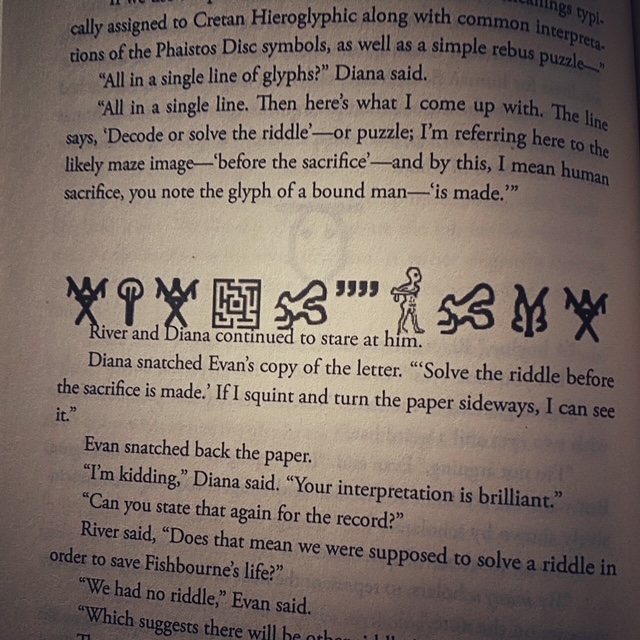At First Light, Dark of Night, and Play of Shadows form one of the richest, brainiest mystery-thriller trilogies around.
There is much to like about all three books, but here’s my favorite element—the two main characters are each smart in their own way. In the case Dr. Evan Wilding, in fact, wicked smart.
But Barbara Nickless doesn’t saddle either Evan or Chicago detective Addie Bissset with some cliché, tropey weakness—no Kryptonite, no fear of snakes, no random character flaw. True, Addie is squeamish about rats but Nickless doesn’t overplay it. Addie and Evan are two sharp people and, yes, there’s considerable romantic tension between them (no spoilers here about the fate of that strain in the latest, Play of Shadows), but they are simply allowed to lead the charge as they sort their way through a series of grisly murders.
At First Light: A dead body in the Calumet River, mysterious glyphs, Viking poetry—much to decipher.
Dark of Night: Death by snake bite for a murdered professor of history, ancient artifacts—much to decipher.
Play of Shadows: A dead lawyer in a Chicago alley, a swirl of Greek mythology, a Minotaur—and much to decipher.
Language and symbol puzzles are at the backbone of all three novels and that’s where Dr. Evan Wilding comes in.
“An Oxford-education Englishman, a professor of semiotics, linguistics, and paleography at the University of Chicago, not to mention an interpreter for government agencies on the writings and symbols left by killers and terrorists, Evan loved codes made up of letters and crime scenes strewn with bizarre symbols. Those, he could read. Maybe not easily or all at once. But, sooner or later, he would decipher their secrets.” (That’s from Play of Shadows.)
And, yes, Dr. Evan Wilding is a dwarf. And owner of a hawk (Ginny) and a plump corgi (Perro). Evan skipped high school and went straight to the university. And he’s older brother to archaeologist River and his “restless refinement … as if James Bond and Lara Croft had a borne a love child.”
River shows up in Play of Shadows in a dramatic and unexpected fashion, zooming in from Istanbul. It’s River who discovers a padded envelope on his brother’s doorstep. Even Evan did not know his brother was on the way from the Middle East, but the note inside is addressed to both “Doctors Wilding.” And alongside the note is an ancient coin and the note: “Let the game begin, as they say. I trust you will find it rewarding.”
Meanwhile, Addie is with the body of a murder victim in The Loop. It looks like the victim has been bitten and there are some strange markings on his forehead. His mouth and eyes are taped shut.
Who you gonna call?
Dr. Evan Wilding, of course.
It quickly turns out that the victim is the guy who dropped off the package at Dr. Wilding’s home. Mazes, labyrinths, hieroglyphs, glyphs, codes, ancient coins, syllabograms, logograms, pictograms, mythology, theater—there happens to be a citywide read of Edith Hamilton’s Mythology underway, too. (Keep a finger tucked at the glossary of Play of Shadows, page 415.)
Dr. Evan Wilding brings the brain, Addie Bisset brings the street smarts. She and three brothers chose policing careers, a fourth brother went into politics. The politician is gay, a secret Addie helps hold. Her mother died when Addie was seven and she “had grown up in an environment so think with testosterone that she was amazed simply breathing in the air at the dinner table hadn’t put hair on her chest.” (At First Light.) Addie, we learned in that first book, “doesn’t need anyone to smooth her feathers.”
The combination of Evan and Addie is entertaining and refreshing because Nickless steers clear of the usual partner spats and fake witty banter. Evan and Addie respect each other; we do, too.
I don’t know how many readers out there would be able to keep up with Evan’s work deciphering all the clues in Play of Shadows. The pages are interspersed with drawings of the symbols and shapes as they come. The puzzle matters, sure, but from it springboards myriad thoughts on the nature of man, the origins of evil, and the killer’s “why.” This third entry in the series leads to a maze and draws Addie underground to a vast network of caves as the tense chase reaches its climax.
Play of Shadows, like the first two books in the series, isn’t afraid of rich material, manifold clues, complex characters, and a vibrant feast of ideas.
++
Previously reviewed:
Sydney Parnell Series:
Blood on The Tracks (Includes Q & A with Barbara Nickless)




